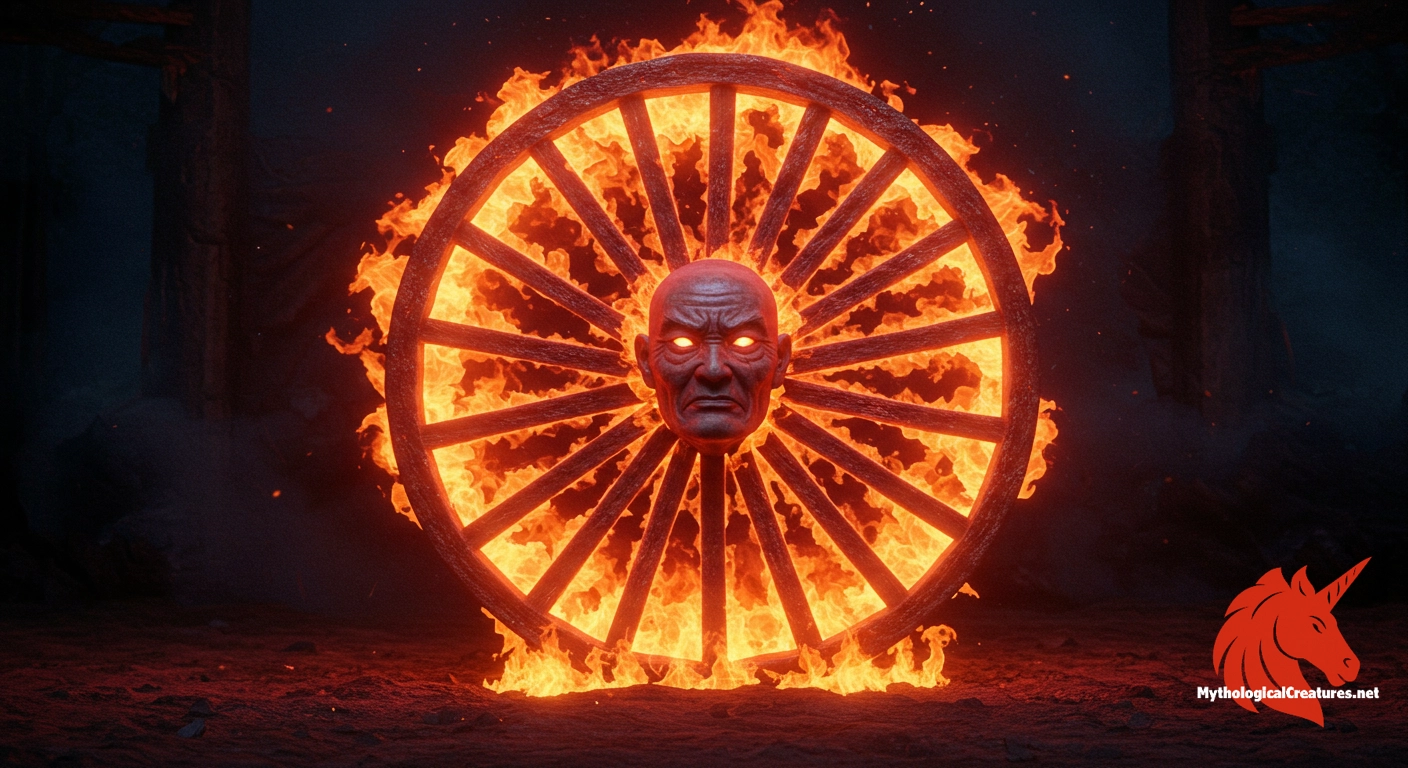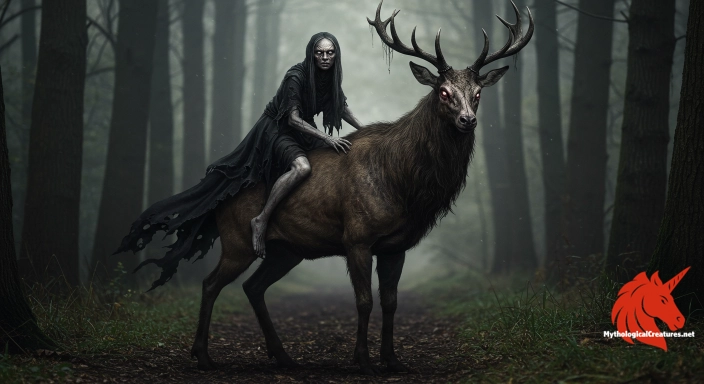Wanyūdō: Wanyūdō is a fearsome Japanese yōkai depicted as a flaming, rolling wheel with a monk's face.

Wanyūdō
Wanyūdō - Represents the inevitability of death and the cycle of rebirth, symbolised by his burning wheel form.
Origins & First Encounters
Wanyūdō is a striking yōkai whose legend weaves together elements of divine retribution and mystic transformation. Emerging from the murky depths of the Heian period, his earliest appearances attest to a long-standing cultural intrigue embedded within Japanese spiritual history. Bearing the evocative monikers ‘Firewheel’ and ‘Soultaker’, his name, which literally translates as ‘wheel monk’, hints at a dual symbolism that blurs the lines between sacred and sinister. His presence in classical art and literature underscores a cultural dialogue about the ephemeral nature of existence and the cyclical rhythm of life. The visual and narrative motifs surrounding this creature suggest that he embodies both the liberating fire of renewal and the destructive force of damnation. Artists and storytellers have often leveraged his image to encapsulate the transient boundary between life and the netherworld. Throughout generations, his depiction has oscillated between a cautionary emblem and a fantastical guardian of cosmic order. The layered interpretations that have arisen around his character mirror the broader complexity of yōkai lore in Japan. His enduring myth resonates as a vivid allegory for fate, punishment, and the inescapable passage of time.
Source Texts & Tale Variants
The principal visual record of Wanyūdō can be traced back to Toriyama Sekien’s illustrious collection, Konjaku Gazu Zoku Hyakki, which skilfully captures the eerie essence of this yōkai. Historical texts from the Heian period also hint at his presence, weaving his legend into the broader tapestry of early Japanese supernatural lore. Certain retellings paint him as both a spectral harbinger and a vengeful spirit, whose very appearance portends an otherworldly reckoning. In folk narratives, his myth is often intertwined with regional warnings and moral lessons aimed at curbing sinful behaviour. Diverse manuscript traditions have modified his traits, sometimes augmenting his role as an executor of cosmic justice. Local storytellers have adapted his image to reflect community values and the local landscape, thereby enriching his narrative versatility. Variations in textual sources reveal that while his visual portrayal remains largely consistent, the underlying interpretations differ markedly among authors. Later adaptations in Edo period literature further diversified his myth, integrating dramatic elements that have echoed into modern retellings.
Form & Powers
Wanyūdō is vividly envisioned as a massive, rolling wheel aglow with an inner conflagration, its brilliant flames encapsulating a potent duality of beauty and terror. His form is almost entirely defined by the circular, fiery motion that symbolises both the unceasing march of time and the eternal cycle of rebirth. Central to his depiction is the subtle integration of a monk’s visage, an uncanny blend of human and supernatural elements that intensifies his enigmatic nature. The wheel’s surface is often rendered in hues of deep red and ochre, with intricate, ribbed textures that evoke the appearance of ancient armour or sacred talismans. This daring imagery is further enhanced by occasional references to ghostly eyes and a somber countenance emerging from within the spinning mass. In some artistic traditions, his size fluctuates dramatically—from an imposing celestial phenomenon to a more intimate, yet equally daunting, presence. The interplay of light and shadow on his form conveys a dynamic tension between illumination and obscurity. Each visual detail, from the flickering flames to the nuanced facial features, enriches his portrayal as both a guardian of spiritual order and a formidable spectral force.
Regional Faces
Although Wanyūdō is a figure deeply rooted in Japanese lore, his depiction varies significantly from one region to another. In more remote parts of Japan, locals have often portrayed him as a far more menacing and aggressive force, seamlessly interwoven with regional superstitions. For example, in some rural districts, his fiery presence is linked to local myths of cursed sites and haunted roadways, intensifying his reputation as an omen of impending misfortune. In contrast, urban reinterpretations sometimes soften his terror, imbuing him with a reflective, almost meditative quality that speaks to inner spiritual battles. Coastal areas have notably adapted his legend, merging it with maritime traditions where his rolling flames are seen as guiding lights for lost souls at sea. Variations also emerge in the intensity and hue of his fire, reflecting local aesthetic preferences and climatic influences. Even as artists and chroniclers modify details to fit regional narratives, the core essence of Wanyūdō remains consistent—a spectral wheel that embodies both retribution and renewal. These local adaptations not only underscore the adaptability of his myth but also highlight the vibrant diversity within Japan’s regional folklore.
Cultural Parallels
Wanyūdō’s myth shares intriguing parallels with numerous global legends that focus on the themes of cyclicality and cosmic justice. His rolling, fiery form bears a conceptual resemblance to the eternal flames found in other cultural traditions, where fire symbolizes both creation and destruction. There exists a notable similarity with the ancient idea of a chariot or wheel that carries divine power, a motif observed in various Indo-European traditions. Comparisons might also be drawn with the cyclical calendars and seasonal rituals of Celtic lore, where the wheel serves as an emblem of eternal recurrence and transformation. Additionally, his dual nature of both tormentor and guide echoes the narratives of other Asian deities whose fiery aspects are used to both punish transgressions and illuminate the path to redemption. His narrative finds a counterpart in the spectral figures of neighbouring cultures, suggesting a shared human fascination with the uncontrollable forces of fate. Such cross-cultural echoes reinforce the idea that the burning wheel is a universal symbol of the inescapable nature of destiny and punishment. By examining these parallels, one can appreciate how Wanyūdō encapsulates a mythic archetype that transcends cultural boundaries, uniting diverse traditions under the symbol of an ever-turning wheel.
Legacy & Modern Evolution
The evolution of Wanyūdō’s image over the centuries mirrors the dynamic interplay between tradition and creative reinterpretation. Early depictions, rooted in the austere aesthetics of the Heian period, positioned him as a formidable emissary of divine retribution. As Japan transitioned into the Edo period, his character was increasingly romanticised and layered with additional symbolic meanings, often illustrated with elaborate brushwork and vibrant intensities. Modern adaptations have continued this trajectory, reimagining his form to resonate with contemporary themes of fate, morality, and the clash between the spiritual and the modern world. In modern pop culture, his image frequently appears in anime, films, and graphic novels, where creators draw on his rich legacy to illustrate inner conflicts and societal issues. The ever-shifting portrayals of Wanyūdō underline a broader cultural willingness to embrace and reinterpret ancient myths for new audiences. His fiery wheel now serves as a metaphor for the relentless passage of time and the transformative power of both destruction and renewal. As modern media further explore his myth, Wanyūdō remains a poignant reminder of Japan’s deep historical roots and the timeless allure of its supernatural lore. Through continual reinvention, his legacy endures as an emblem of both caution and inspiration in an ever-changing world.
Interesting Fact
Wanyūdō’s design as a flaming wheel challenges conventional representations of mobility and punishment in folklore, symbolising both the relentless passage of time and the inescapability of fate.
Quick Creature Info
Associations:
Our Mythic Legendary Rating:

Also Sometimes Known As:
Habitat:
Supernatural Powers:
Physical Attributes:
Abilities:
Behavior:
Lore:
References
Discover Another Mythical Legend You May Not Have Heard Of?
Uncover the mysteries of ancient folklore and expand your knowledge of legendary beings from cultures around the world.
Dare to Meet the Buckriders....
Mythical Disclaimer: The images and data on this site are derived from various historical and literary sources, but we have found that many myths often have multiple versions and interpretations across references, sometimes contradictory. As a result, these creature depictions are artistic interpretations—imaginative blends of folklore, legend, and a dash of AI guesswork. Because creature descriptions vary widely, our illustrations and accompanying information represent our best effort to honor mythology while bridging creative gaps. Enjoy these interpretations—just remember, we've done our best to respect the stories and validate available data, but in the realm of mythology, details often shift, imagination leads the way, and nothing is ever set in stone!
Curated by the Mythological Creatures Team (rev. May 2025)
